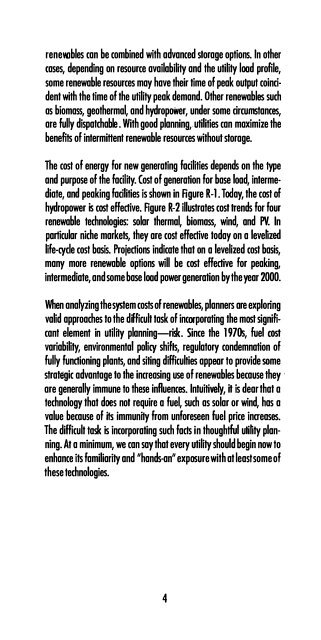DSM Pocket Guidebook Volume 5: Renewable and Related ... - NREL
DSM Pocket Guidebook Volume 5: Renewable and Related ... - NREL
DSM Pocket Guidebook Volume 5: Renewable and Related ... - NREL
Create successful ePaper yourself
Turn your PDF publications into a flip-book with our unique Google optimized e-Paper software.
eneWJbles can be combined with advanced storage options. In other<br />
cases, depending on resource availability <strong>and</strong> the utility load profile,<br />
some renewable resources may have their time of peak output coincident<br />
with the lime of the utility peak dem<strong>and</strong>. Other renewables such<br />
as biomass, geothermal, <strong>and</strong> hydropower, under some circumstances,<br />
are ful dispalchable. With good planning, utilities can maximize the<br />
benefits of inlermillenl renewable resources without storage.<br />
The cost of energy for new generating facilities depends on the type<br />
<strong>and</strong> purpose of the faciiHy. Cost of generation for base load, intermediate,<br />
<strong>and</strong> peaking facilities is shown in Figure R-1. Today, the cost of<br />
hydropower is cost effective. Figure R-2 illustrates cos! !rends for four<br />
renewable technologies: solar thermal, biomass, wind, <strong>and</strong> PV. In<br />
particular niche markets, they are cos! effective today on a levehzed<br />
life-cycle cost basis. Projections indicate that on a levelized cost basis,<br />
many more renewable options will be cost effective for peaking,<br />
intermediate, <strong>and</strong> some base load power generation by the year 2000.<br />
When anaing the system costs of renewables, planners are exploring<br />
valid approaches to the difficult task of incorporating the most significant<br />
element in utiiHy planning-risk. Since the 1970s, fuel cost<br />
variability, environmental policy shifts, regulatory condemnation of<br />
ful functioning plants, <strong>and</strong> siting difficulties appear to provide some<br />
strategic advantage lo the increasing use of renewables because they ·<br />
are general immune to these influences. Intuitive, if is dear that a<br />
technology that does no! require a fuel, such as solar or wind, has a<br />
value because of its immunHy from unforeseen fuel price increases.<br />
The difficult task is incorporating such facls in thoughtful ulihty planning.<br />
AI a minimum, we can say that every utility should begin now to<br />
enhance its familiarity <strong>and</strong> "h<strong>and</strong>s-an" exposure with at leas! some of<br />
these technologies.<br />
4
















